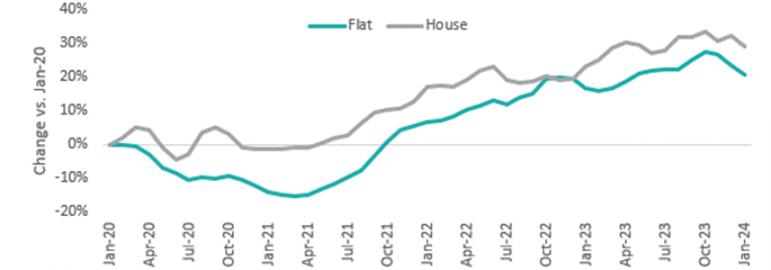 It has been a relatively positive start to the year as the number of properties going under offer grew by 5.4% on an annual basis in January. While the number of new sales instructions increased by 4.2% over the same period. The volume of stock available for sale at the end of January is 5.4% higher than at the same point a year earlier.
It has been a relatively positive start to the year as the number of properties going under offer grew by 5.4% on an annual basis in January. While the number of new sales instructions increased by 4.2% over the same period. The volume of stock available for sale at the end of January is 5.4% higher than at the same point a year earlier.
However, average achieved sold prices fell by 7.1% in January on an annual basis, the largest fall in almost five years. There were 15.5% fewer transactions in January compared to the same month a year earlier, and 6.9% fewer than the 2017-2019 (pre-pandemic) January average (table 1), according to the data for January, provided by LonRes,
Table 1 – Monthly Prime Data – January
| Prime Sales | Prime Lettings | |||
| Annual
Change |
Change vs. 2017-19 (pre-pandemic) | Annual
Change |
Change vs. 2017-19 (pre-pandemic) | |
| Achieved prices/rents | -7.1% | -2.5% | 3.1% | 26.1% |
| Properties sold/let | -15.5% | -6.9% | -11.5% | -60.8% |
| New instructions | 4.2% | 9.1% | 22.1% | -48.2% |
Source: LonRes
There are signs of green shoots in the prime London housing market. January saw a rise in the number of properties going under offer and an increase in the number of new sales instructions coming to the market. Fall-throughs and withdrawals have also fallen.
However, this data which is forward looking, is yet to translate into actual sales. As a result, values in January continued to fall slightly month-on-month, with the annual change in achieved prices across prime London falling to -7.1% (table 1), the biggest drop in almost five years. Compared to January 2014, 10 years ago, prices are only 0.8% higher.
Activity also continued where it left off last year, with transactions in January 15.5% lower than the same month a year earlier and 6.9% lower than the 2017-19 January average (table 1).
However, the number of properties going under offer looks more positive, with January seeing an annual increase of 5.4%, taking levels 15.6% above the pre-pandemic average (chart 1).
New sales instructions in January were also up – by 4.2% on the previous year and 9.1% above the 2017-19 average (table 1). Combined with the lower level of sales agreed, this resulted in the number of available homes for sale across prime London being 5.4% higher at the end of January than at the same point last year.
Additional metrics – fall throughs, withdrawals, and price reductions – indicate a relatively healthy market (chart 1). Fall throughs and withdrawals in January were lower than a year ago and price reductions are only 6% higher. With under offer numbers looking significantly better than sales, this continues to lend evidence to the theory that deals are being agreed but are just taking longer to conclude.
Chart 1 – Sales Activity Measures in January 2024, All Prime London
Source: LonRes
Values across prime London are similar to a decade ago on average, but at area and neighbourhood level there have been some variations in performance. Prime central London has seen the least growth over 10 years, at 3.1%, but even within that there are some big differences between adjacent neighbourhoods.
Mayfair and St. James’s saw a change of over 20%, although this will have been boosted by new supply of high-end developments rather than like-for-like value growth. Note that these results are based on achieved prices over the whole calendar year of 2023 vs. 2013, unlike the timelier monthly data in table 1.
Table 2 – Change in Values Over Past 10 Years by Neighbourhood
| Area | Neighbourhood | Value change
(2023 vs 2013) |
Area
Average |
Difference |
| Prime Central London | Chelsea | -0.9% | 3.1% | -3.9% |
| Kensington, Notting Hill & Holland Park | 5.1% | 2.1% | ||
| Knightsbridge & Belgravia | 1.9% | -1.1% | ||
| Mayfair & St James’s | 20.7% | 17.7% | ||
| South Kensington | -2.5% | -5.5% | ||
| Prime Inner | Bayswater & Maida Vale | 10.3% | 18.9% | -8.6% |
| Fitzrovia, Bloomsbury & Soho | 32.6% | 13.8% | ||
| Hampstead | 29.3% | 10.5% | ||
| Kensington, Notting Hill & Holland Park | 26.2% | 7.3% | ||
| Marylebone & Medical Territory | 18.4% | -0.4% | ||
| Pimlico, Westminster & Victoria | 10.4% | -8.4% | ||
| St Johns Wood, Regents Park & Primrose Hill | 15.9% | -3.0% | ||
| Prime Fringe | Battersea, Clapham & Wandsworth | 21.1% | 18.3% | 2.8% |
| Bayswater & Maida Vale | 14.6% | -3.6% | ||
| Fulham & Earls Court | 10.5% | -7.8% | ||
| Hammersmith & Brook Green, Chiswick, North Kensington | 21.9% | 3.7% | ||
| Vauxhall, Nine Elms, Borough & Kennington | 28.8% | 10.5% |
Source: LonRes (Note: figures may not sum due to rounding)
January saw activity in the £5m+ market continue to slip back from a high base, but transaction levels are still well ahead of historical trends. Sales were 17% lower than the same month a year earlier but 64% higher than the pre-pandemic (2017 to 2019) January average. The number of properties at £5m+ going under offer in January this year was unchanged from January 2023, but 28% ahead of the 2017-19 average.
The supply of high-end homes for sale appears to still be increasing. New instructions in January this year were 42% higher than last year and 148% more than the 2017-19 January average. Even with the healthy sales volumes noted above, the stock of £5m+ homes available to buy at the end of January was 25% higher than a year earlier.
A longer-term comparison of stock for sale by price band shows that the build up of available £5m+ stock has been a clear trend since early 2022 (chart 3). Relative to the levels seen at the end of 2019, there were 52% more £5m+ homes for sale across prime London at the end of January. Most of this growth has taken place in the past two years. Other price points followed a similar trajectory in 2022 but, since then, the number of available homes has fallen back, particularly for those priced at under £2m.
Chart 2 – Stock on the Market by Price Band, Compared to End of 2019
Source: LonRes
Rental growth across prime London slowed again in January, with average rents falling on a monthly basis for the third time in succession. Annual rental growth fell to 3.1%, but rental values remain 26.1% higher than their 2017-19 (pre-pandemic) average (table 1).
The number of newly agreed lets in January fell by 11.5% compared to a year earlier and was 60.8% below the pre-pandemic (2017 to 2019) January average. New instructions rose last month by 22.1% on an annual basis, but the figure was 48.2% below the average 2017 to 2019 January level (table 1). Across prime London there were 59.0% more properties on the market to let on 31 January than a year earlier, but that figure is 27.5% lower than the end of January 2020.
In the prime London rental market, flats have typically commanded a premium versus houses, on a £ per sq. ft. basis. At the start of 2020, this premium was 13%. Rental growth for the two property classes has followed differing paths since then. In Q2 2020, the pandemic and associated lockdowns reduced demand for rental property across central London, so values for both types fell (chart 3). Very quickly, this shifted to increased demand for houses relative to flats.
In spring 2021, house rental values were in line with their January 2020 level, while flats were 15% below. Flats subsequently recovered and closed the growth gap in late 2022, but a new gap has opened up since then. The flat premium in January 2024 has fallen to 6%.
Chart 3 – Rental Growth Since January 2020 by Type
Source: LonRes
Nick Gregori, head of research, LonRes, said: “Sentiment appears to be gradually improving for the prime London sales market. Under offer numbers – the timeliest indicator of demand – grew by 5.4% in January on an annual basis and were 15.6% ahead of the longer-term average. New instructions grew by 4.2% compared to a year earlier.
“However, average achieved prices continued to slide, with the largest annual fall in almost five years. And transactions remain relatively subdued, slightly below pre-pandemic levels. More instructions and less sales mean more stock available to buy, with the number of homes for sale growing by 5.4% over the past 12 months.
“The top end of the market is the most active – on a relative basis – as it has been since late 2021. Sales of £5m+ homes across prime London were 17% lower in January than a year earlier, but 64% above their 2017 to 2019 average for the same month. Supply in this market continues to grow, with new instructions in January 42% higher on an annual basis and the number of homes available for sale growing by over 50% in the past 12 months.
“The prime London lettings market continues to slow, although much of this can be explained by the time of year. Rents fell on a monthly basis for the third month in a row, although annual growth remained in positive territory at 3.1%. It appears that rents may have peaked in late 2023, with further growth unlikely in the short term as available stock is growing, particularly at weekly rents above £1,000.”





Comments are closed.